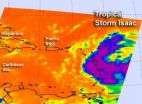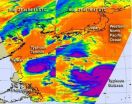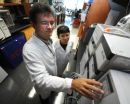(Press-News.org)
VIDEO:
This animation of satellite observations from August 19-22, 2012, shows the development and movement of Tropical Storm Isaac toward the Lesser Antilles. This visualization was created by the NASA GOES...
Click here for more information.
There are now two active tropical cyclones in the Atlantic and NASA is generating satellite imagery to monitor their march westward. Tropical Storm Issac is already bringing rainfall to the Lesser Antilles today, Aug. 22, Tropical Depression 10 formed in the eastern Atlantic, and another low fizzled in the western Gulf of Mexico.
Tropical Storm Isaac formed late on Aug. 21 from Tropical Depression 9 and immediately caused warnings and watches. Tropical Depression 10 formed during the morning hours on Aug. 22 in the central Atlantic, east of Isaac and appears to be following the tropical storm on NOAA's GOES-13 satellite imagery. NOAA's GOES-13 satellite captured an image of Tropical Storm Isaac over the Lesser Antilles, and newborn Tropical Depression 10 trailing behind on Aug. 22 at 1445 UTC (10:45 a.m. EDT). The image was created by the NASA GOES Project at the NASA Goddard Space Flight Center in Greenbelt, Md. Both storms are showing good circulation.
The Atmospheric Infrared Sounder (AIRS) instrument onboard NASA's Aqua satellite captured an infrared image of Tropical Storm Isaac on Aug. 22 at 2:05 a.m. EDT, as it was bringing heavy rainfall to the Lesser Antilles. Strong thunderstorms appeared in a band of thunderstorms in Isaac's western quadrant that had cloud top temperatures as cold as -63F (-52C).
Watches and Warnings in Effect
The National Hurricane Center has posted Warnings and Watches for Tropical Storm Issac. A Tropical Storm Warning is in effect for Martinique, Dominica, Guadeloupe and the surrounding islands, and St. Martin, St. Kitts, Nevis, Antigua, Barbuda, Montserrat, and Anguilla, Saba, St. Eustatius, and St. Maarten, British Virgin Islands, Puerto Rico, Vieques, Culebra, and the U.S. Virgin Islands.
There are also hurricane and tropical storm watches in effect. A Hurricane Watch is in effect for Puerto Rico, Vieques, Culebra, and the U.S. and British Virgin Islands; the south coast of the Dominican Republic from Isla Saona westward to the Haiti-Domenican Republic southern border. A Tropical Storm Watch is in effect for the north coast of the Dominican Republic from the Haiti-Dominican Republic northern border eastward to north of Isla Saona.
At 11 a.m. EDT (1500 UTC) on Aug. 22, Tropical Storm Isaac had maximum sustained winds near 45 mph (75 kmh), and the NHC said that strengthening is forecast. Isaac could become a hurricane by Thursday or Thursday night, Aug. 23. The center of Isaac was about 140 miles (230 km) east of Guadaloupe, near latitude 15.9 north and longitude 59.3 west. Isaac is moving westward near 21 mph (33 kmh) is expected to stay on this track over the next couple of days.
The NHC said, "On the forecast track the center of Isaac should move through the Leeward Islands this evening and pass near or south of the Virgin Islands and Puerto Rico on Thursday (Aug. 23) and approach the Dominican Republic Thursday night and Friday (Aug. 24).
System 95L Fizzles Out
The third low pressure area that forecasters had been watching for possible development has fizzled out, now that it moved inland in northeastern Mexico. The NHC gives it a "near zero percent" chance of development now.
INFORMATION:
Images and storm history: http://www.nasa.gov/mission_pages/hurricanes/archives/2012/h2012_TD9.html
NASA sees Tropical Storm Isaac and Tropical Depression 10 racing in Atlantic
2012-08-23
ELSE PRESS RELEASES FROM THIS DATE:
University of Colorado analysis of election factors points to Romney win
2012-08-23
A University of Colorado analysis of state-by-state factors leading to the Electoral College selection of every U.S. president since 1980 forecasts that the 2012 winner will be Mitt Romney.
The key is the economy, say political science professors Kenneth Bickers of CU-Boulder and Michael Berry of CU Denver. Their prediction model stresses economic data from the 50 states and the District of Columbia, including both state and national unemployment figures as well as changes in real per capita income, among other factors.
"Based on our forecasting model, it becomes clear ...
Double trouble continues in the Philippine Sea: Tembin and Bolaven
2012-08-23
Typhoon Tembin and Typhoon Bolaven continue to churn in the Philippine Sea, and infrared satellite data from NASA showed the power within both storms.
The Atmospheric Infrared Sounder (AIRS) instrument that flies onboard NASA's Aqua satellite captured imagery of both storms on Aug. 21 in two different overpasses. Aqua flies over the same locations during early morning and early afternoon (local time) as it orbits the Earth. Aqua passed over the Philippine Sea on Aug. 21 at 04:41 UTC (12:41 a.m. EDT) and 16:47 UTC (12:47 p.m. EDT). The two satellite passes were combined ...
Scientists from UCLA, Israel's Technion uncover brain's code for pronouncing vowels
2012-08-23
Scientists at UCLA and the Technion, Israel's Institute of Technology, have unraveled how our brain cells encode the pronunciation of individual vowels in speech.
Published in the Aug. 21 edition of the journal Nature Communications, the discovery could lead to new technology that verbalizes the unspoken words of people paralyzed by injury or disease.
"We know that brain cells fire in a predictable way before we move our bodies," said Dr. Itzhak Fried, a professor of neurosurgery at the David Geffen School of Medicine at UCLA. "We hypothesized that neurons would ...
Video shows the traffic inside a brain cell
2012-08-23
Using bioluminescent proteins from a jellyfish, a team of scientists has lit up the inside of a neuron, capturing spectacular video footage that shows the movement of proteins throughout the cell.
The video offers a rare peek at how proteins, the brain's building blocks, are directed through neurons to renew its structure. It can be viewed online here: http://www.youtube.com/watch?v=baI9q2--q7s&feature=youtu.be
"Your brain is being disassembled and reassembled every day," said Don Arnold, associate professor of molecular and computational biology at the USC Dornsife ...
ORNL researchers probe invisible vacancies in fuel cell materials
2012-08-23
Knowing the position of missing oxygen atoms could be the key to cheaper solid oxide fuel cells with longer lifetimes. New microscopy research from the Department of Energy's Oak Ridge National Laboratory is enabling scientists to map these vacancies at an atomic scale.
Although fuel cells hold promise as an efficient energy conversion technology, they have yet to reach mainstream markets because of their high price tag and limited lifespans. Overcoming these barriers requires a fundamental understanding of fuel cells, which produce electricity through a chemical reaction ...
Targeting inflammation to prevent, treat cancers
2012-08-23
Augusta, GA—Researchers at the Georgia Health Sciences University Cancer Center have identified a gene that disrupts the inflammatory process implicated in liver cancer.
Laboratory mice bred without the gene lacked a pro-inflammatory protein called TREM-1 and protected them from developing liver cancer after exposure to carcinogens.
The study, published in Cancer Research, a journal for the American Association for Cancer Research, could lead to drug therapies to target TREM-1, said Dr. Anatolij Horuzsko, an immunologist at the GHSU Cancer Center and principal investigator ...
Elusive metal discovered
2012-08-23
Washington, D.C.—Carnegie scientists are the first to discover the conditions under which nickel oxide can turn into an electricity-conducting metal. Nickel oxide is one of the first compounds to be studied for its electronic properties, but until now scientists have not been able to induce a metallic state. The compound becomes metallic at enormous pressures of 2.4 million times the atmospheric pressure (240 gigapascals). The finding is published in Physical Review Letters.
"Physicists have predicted for decades that the nickel oxide would transition from an insulator—a ...
Northwestern scientists create chemical brain
2012-08-23
Northwestern University scientists have connected 250 years of organic chemical knowledge into one giant computer network -- a chemical Google on steroids. This "immortal chemist" will never retire and take away its knowledge but instead will continue to learn, grow and share.
A decade in the making, the software optimizes syntheses of drug molecules and other important compounds, combines long (and expensive) syntheses of compounds into shorter and more economical routes and identifies suspicious chemical recipes that could lead to chemical weapons.
"I realized that ...
Key to burning fat faster discovered
2012-08-23
Enzymes involved in breaking down fat can now be manipulated to work three times harder by turning on a molecular switch recently observed by chemists at the University of Copenhagen. Being able to control this chemical on/off button could have massive implications for curing diseases related to obesity including diabetes, cardio vascular disease, stroke and even skin problems like acne. But the implications may be wider.
The results suggest that the switch may be a common characteristic of many more enzymes. Since enzymes are miniscule worker-molecules that control a ...
Primate of the opera: What soprano singing apes on helium reveal about the human voice
2012-08-23
AUDIO:
This is a gibbon call without helium.
Click here for more information.
Have you ever heard an opera singing ape? Researchers in Japan have discovered that singing gibbons use the same vocal techniques as professional soprano singers. The study, published in the American Journal of Physical Anthropology, explains how recording gibbons singing under the influence of helium gas reveals a physiological similarity to human voices.
The research was led by Dr Takeshi Nishimura ...



